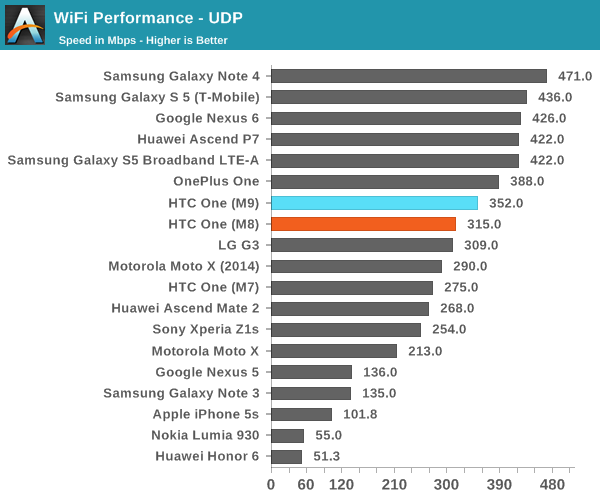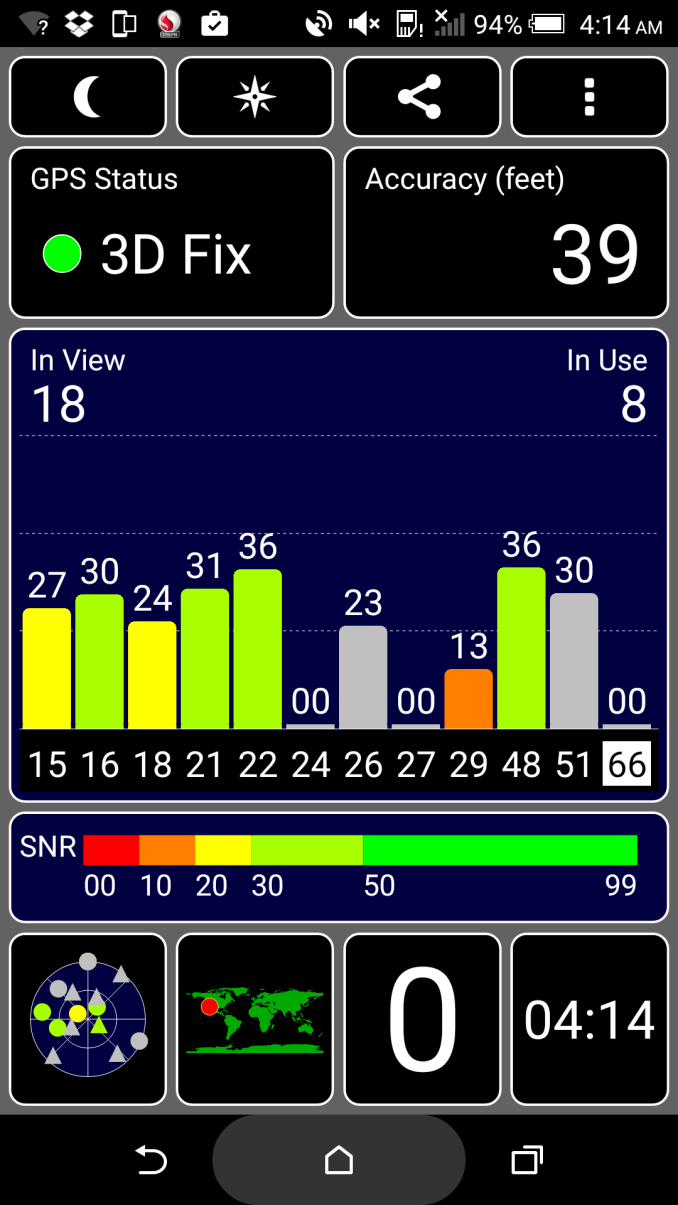The HTC One M9 Review: Part 2
by Joshua Ho on April 6, 2015 10:00 AM EST- Posted in
- Smartphones
- HTC
- Qualcomm
- Mobile
- Snapdragon 810
- One M9
WiFi Performance
Fundamentally, a smartphone is defined by its ability to connect to the internet. Although cellular data is important, WiFi performance is crucial for anyone on a limited data plan and in areas where cellular data is slow or nonexistent. To this end, HTC has outfitted the One M9 with Broadcom’s BCM4356 WiFi/BT combo chipset, which we’ve seen before in the Nexus 6. This chipset supports 2x2 802.11ac, but the One M9 only supports a maximum 433 Mbps physical link rate, which means that it’s only using a single spatial stream. I haven’t been able to find any information on the antenna configuration of the One M9, but it’s likely that HTC is only using a single antenna for WiFi on the One M9 which would make it similar to the One M7 and One M8 in that regard. In order to test how this configuration performs, we use IPerf on Android connected to a PC to see how rapidly the device can send UDP packets.

As one can see, there’s a reasonable performance uplift when compared to Qualcomm Atheros’ WCN3680 WiFi/BT combo chip, but it isn’t as big as moving to a 2x2 MIMO configuration. The lack of MIMO also has implications for WiFi range, but WiFi signals degrade quickly enough that this wouldn’t be a massive difference.
GNSS
As the One M9 uses a Qualcomm modem, it's a pretty safe bet that it also uses the modem for GNSS location services. In practice, this means that the One M9 locks on to satellites quickly any time it's possible to download assistance data to speed up GPS.
Without assistance data, the One M9 seems to have worse performance than expected, although weather conditions can always affect overall performance. Time to first lock took a minute and 42 seconds, and accuracy wasn't quite as high as one would hope, tending towards 30 foot accuracy rather than 10 foot accuracy. It's likely that local weather conditions were responsible for this issue, as subjectively it seemed that GPS performance was comparable to other phones tested at the same time.











127 Comments
View All Comments
sinPiEqualsZero - Monday, April 6, 2015 - link
I would have been happy with it being similar to the M8 if it didn't regress in so many categories. There must have been a new manager or director somewhere along the line as the M8 was right up there with all of the flagships.And as Refuge pointed out the M8 was released for Windows. I wasn't ready to upgrade my Lumia 928 then but it sure is showing its age now. With no viable WP flagship coming up I think it's time to switch. Bah.
kspirit - Tuesday, April 7, 2015 - link
Wait for the upcoming Lumia flagship. It'll be the same wait until when HTC launches the M9 for Windows as well. I'm holding on to my 925 until the WP10 Lumia announcement myself :) Although an "Ativ" S6 would be quite the marvellous device.sinPiEqualsZero - Wednesday, April 8, 2015 - link
I'm not holding my breath for it. It's been rumored for well over a year and there's still no release date. I'm making my decision around mid to late May and if it isn't out by then I'm doing Android.Flunk - Monday, April 6, 2015 - link
At one point HTC was the company to beat when it came to Android Smartphones. It seems like all they do now is make inferior clones of the HTC One (M7 in HTC-speak). It seems like they're actively trying to fail, especially since they're a practical non-entity marketing wise and Apple and Samsung dump millions into marketing.pedromcm.pm - Monday, April 6, 2015 - link
Apple and Samsung will bury the M9 because their products are better, not because of marketing.hung2900 - Monday, April 6, 2015 - link
And shooting in 0.5 shutter? R u serious? These photos were shot by tripod.DanNeely - Monday, April 6, 2015 - link
Half a second is the total time to take and save an image; not the shutter time. Most of it is pre-processing between when the button is pressed and the sensor exposed, post-processing after eposure to turn the raw image from the sensor into something to show on the screen and save as a jpeg, and the time spend to write to flash itself.GC2:CS - Monday, April 6, 2015 - link
So the snapdragon 810 overheating and efficiency problems are more or less included in this phone ?That's very bad.
I heard about adreno 420 throttling problems which limited it to "not so much faster than 801" and this 810 is just a bit faster than 805.... We had seen a big perf jump from M7 to M8 but where are those 80% improved performance that qualcom promised last year compared to adreno 330 ?
And 20nm should have brought some rather significant efficiency gains... So what happened ? Apple is leaving only low quality wafers to their competition at TSMC or what ?
Because A8 is maybe slower at imediate benchmarks but the combination of a suposedly far more efficient architecture than the competition ( little heat = little throtling) and relativelly low resolution displays makes iPhones fly.
I even seen that galaxy S6 has problems sustaining their performance and even bigger than HTC thanks to it's QHD display.
Maybe the LG G4 can surprise us as snapdragon 808 could possibly sustan performance better....
Refuge - Monday, April 6, 2015 - link
LG sure does know how to make a phone.My girlfriend has had both the G2 and G3 now.
These things are amazing, fantastic speakers, absolutely gorgeous screen, fast and clear camera, fastest phone I've been able to play with in awhile, and also the battery life? My old lady is glued to her phone for work constantly, and she can get 2 days out of it. If I were to use it I could get 3.
I would switch myself from my M7 to one, but I hate the sleep button on the back, and I hate how big it is! Those are really big screens, too much for me to be interested in it being in my pocket on the regular.
kspirit - Tuesday, April 7, 2015 - link
+1 for the G2 and G3. Hopefully the G4 will slay just as hard.